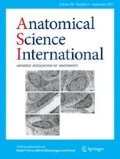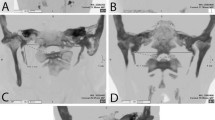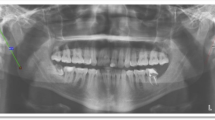Abstract
The study determines the variability of the length of the styloid process in a Greek population and investigates how it is affected by gender and age; it also evaluates the side asymmetry, highlighting clinical implications. One hundred and forty-nine dry adult modern skulls (94 male and 55 female) were divided into subgroups according to their age: 20–39, 40–59 and older than 60 years. The lengths of 262 styloid processes (127 right and 135 left-sided) were measured. The lengths of right-sided styloid processes ranged from 6.4 to 70.2 mm and left-sided styloid processes from 5.2 to 69.0 mm. The processes were classified according to their lengths as short <18 mm, normal 18–33 mm and elongated >33 mm. The majority of the processes were normal (45.8 %), 27.5 % were short and 26.7 % elongated. No statistical significant correlation was established among the lengths of the styloid processes, gender and age. Side asymmetry was found only in the group with elongated styloid processes (right processes were longer, 28.3 %, than the left ones 25.2 %; p = 0.016). Our study contributes to the literature, adding important information about the length of the styloid process and its diversity in the Greek population. It also confirms the existence of an osseous landmark as a starting point for the measurement of the length of the styloid process and proposes a method of measurement for the evaluation of the actual length of the styloid process.







Similar content being viewed by others
References
Bagga MB, Kumar CA, Yeluri G (2012) Clinicoradiologic evaluation of styloid process calcification. Imaging Sci Dent 42:155–161
Başekim CC, Mutlu H, Güngör A et al (2005) Evaluation of styloid process by three-dimensional computed tomography. Eur Radiol 15:134–139
Bejjani GK, Sullivan B, Salas-Lopez E et al (1998) Surgical anatomy of the infratemporal fossa: the styloid diaphragm revisited. Neurosurgery 43:842–852
Camarda AJ, Deschamps C, Forest D (1989) Stylohyoid chain ossification: a discussion of etiology. Oral Surg Oral Med Oral Pathol 67:508–514
Dao A, Karnezis S, Lane JS 3rd, Fujitani RM, Saremi F (2011) Eagle syndrome presenting with external carotid artery pseudoaneurysm. Emerg Radiol 18:263–265
Eagle WW (1948) Elongated styloid process: further observations and a new syndrome. Arch Otolaryngol 47:630–640
Eagle WW (1949) Symptomatic elongated styloid process: report of 2 cases of styloid process-carotid artery syndrome with operation. Arch Otolaryngol 49:490–503
Eagle WW (1958) Elongated styloid process; symptoms and treatment. AMA Arch Otolaryngol 67:172–176
Frommer J (1974) Anatomic variations in the stylohyoid chain and their possible clinical significance. Oral Surg Oral Med Oral Pathol 38:659–667
Fusco DJ, Asteraki S, Spetzler RF (2012) Eagle’s syndrome: embryology, anatomy, and clinical management. Acta Neurochir 154:1119–1126
Goss CM (1973) Osteology. In: Gray’s anatomy. 29th edn. Lea and Febiger, Philadelphia, p 173
Gozil R, Yener N, Calguner E et al (2001) Morphological characteristics of styloid process evaluated by computerized axial tomography. Ann Anat 183:527–535
Guo B, Jaovisidha S, Saptoris DJ et al (1997) Correlation between ossification of the stylohyoid ligament and osteophytes of the cervical spine. J Rheumatol 24:1575–1581
Ilgüy M, Ilgüy D, Güler N, Bayirli G (2005) Incidence of the type and calcification patterns in patients with elongated styloid process. J Int Med Res 33:96–102
Johnson CP, Scraggs M, How T, Burs J (1995) A necropsy and histomorphometric study of abnormalities in the course of the vertebral artery associated with ossified stylohyoid ligaments. J Clin Pathol 48:637–640
Jung T, Tschernitschek H, Hippen H et al (2004) Elongated styloid process: when is it really elongated? Dentomaxillofac Radiol 33:119–124
Keur JJ, Campbell JPS, McCarthy JF, Ralph WJ (1986) The clinical significance of the elongated styloid process. Oral Surg 61:399–404
Kursoglu P, Unalan F, Erdem T (2005) Radiological evaluation of the styloid process in young adults resident in Turkey’s Yeditepe University faculty of dentistry. Oral Surg Oral Med Oral Pathol Oral Radiol Endod 100:491–494
Lykaki G, Papadopoulos N (1988) The ossified Hyoid Apparatus—morphology, interpretation, clinical and functional significance. Presentation of a rare case and highlights of the literature. Anat Anz 166:187–193
Moffat DA, Ramsden RT, Shaw HJ (1977) The styloid process syndrome: aetiological factors and surgical management. J Laryngol Otol 91:279–294
Monsour P, Young W (1986) Variability of the styloid process and stylohyoid ligament in panoramic radiographs. Oral Surg Oral Med Oral Pathol 61:522
Natsis K, Piagkou M, Skotsimara G et al (2013) The ossified pterygoalar ligament: an anatomical study with pathological and surgical implications. J Craniomaxillofac Surg. doi:10.1016/j.jcms.2013.10.003 [Epub ahead of print]
Piagkou M, Anagnostopoulou S, Kouladouros K, Piagkos G (2009) Eagle’s syndrome: a review of the literature. Clin Anat 22:545–558
Ramadan SU, Gokharman D, Tuncbilek I et al (2007) Assessment of the stylohoid chain by 3D-CT. Surg Radiol Anat 29:583–588
Rath G, Anand C (1991) Abnormal styloid process in a human skull. Surg Radiol Anat 13:227–229
Rechtweg JS, Wax MK (1998) Eagle’s syndrome: a review. Am J Otolaryngol 19:316–321
Sisman Y, Gokce C, Tarim Ertas E et al (2009) Investigation of elongated styloid process prevalence in patients with torus palatines. Clin Oral Investig 13:269–272
Sokler K, Sandev S (2001) New classification of the styloid process length-clinical application on the biological base. Coll Antropol 25:627–632
Vougiouklakis T (2006) Overview of the ossified styloid ligament based in more than 1200 forensic autopsies. J Clin Forensic Med 13:268–270
Acknowledgments
This study has not received any funding support. There was no contribution of other colleagues or institutions.
Conflict of interest
The authors declare no conflict of interest for this study.
Author information
Authors and Affiliations
Corresponding author
Rights and permissions
About this article
Cite this article
Natsis, K., Repousi, E., Noussios, G. et al. The styloid process in a Greek population: an anatomical study with clinical implications. Anat Sci Int 90, 67–74 (2015). https://doi.org/10.1007/s12565-014-0232-3
Received:
Accepted:
Published:
Issue Date:
DOI: https://doi.org/10.1007/s12565-014-0232-3




